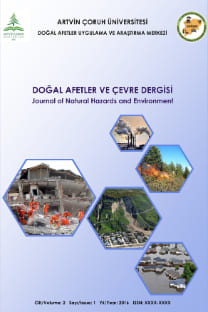Yanmış Alanların Sentinel-2 MSI ve Landsat-8 OLI ile Tespiti ve Analizi: Çanakkale/Gelibolu Orman Yangını
Detection and Analysis of Burned Areas with Sentinel-2 MSI and Landsat-8 OLI: Çanakkale / Gelibolu Forest Fire
___
- Chen G., Metz M.R., Rizzo D.M., Meentemeyer R.K., (2015), Mapping burn severity in a disease-impacted forest landscape using Landsat and ASTER imagery, International Journal of Applied Earth Observation and Geoinformation, 40(2015), 91-99.
- Chung, M., Jung, M., & Kim, Y., (2019), Wildfire damage assessment using multi-temporal Sentinel-2 data, International Archives of the Photogrammetry, Remote Sensing and Spatial Information Sciences - ISPRS Archives, 42(3/W8), 97-102.
- Çolak E., Sunar A.F., (2018), Remote sensing & GIS integration for monitoring the areas affected by forest fires: A case study in Izmir, Turkey, International Archives of the Photogrammetry, Remote Sensing and Spatial Information Sciences-ISPRS Archives, 42(3W4), 165-170.
- Dereli M., (2019), Sentinel-2A uydu görüntüleri ile Giresun il merkezi için kısa dönem arazi örtüsü değişiminin belirlenmesi, Afyon Kocatepe Üniversitesi Fen ve Mühendislik Bilimleri Dergisi, 19(2), 361-368.
- Flasse S., (2005), Remote sensing and GIS accuracy assessment, The Photogrammetric Record, 20(111), 306-307.
- Fornacca D., Ren G., Xiao W., (2018), Evaluating the best spectral indices for the detection of burn scars at several post-fire dates in a mountainous region of northwest Yunnan, China, Remote Sensing, 10(8), 1196, doi: 10.3390/rs10081196.
- García-Llamas P., Suárez-Seoane S., Fernández-Guisuraga J. M., Fernández-García V., Fernández-Manso A., Quintano C., Taboada A., Marcos E., Calvo L., (2019), Evaluation and comparison of Landsat-8, Sentinel-2 and Deimos-1 remote sensing indices for assessing burn severity in Mediterranean fire-prone ecosystems, International Journal of Applied Earth Observation and Geoinformation, 80(2019), 137–144.
- Gonçalves A.C., Sousa A.M.O., (2017), The fire in the mediterranean region: a case study of forest fires in Portugal, Mediterranean Identities - Environment, Society, Culture, Prof. Borna Fuerst-Bjeliš (Ed.), ss. 305-335. doi:10.5772/intechopen.69410.
- Keeley J.E., (2009), Fire intensity, fire severity and burn severity: A brief review and suggested usage, International Journal of Wildland Fire, 18(1), 116-126.
- Kesgin Atak B., Tonyaloğlu E., (2020), Evaluating spectral indices for estimating burned areas in the case of Izmir/Turkey, Eurasian Journal of Forest Science, 8(1), 49-59.
- Liu Y., Stanturf J., Goodrick S., (2010), Trends in global wildfire potential in a changing climate, Forest Ecology and Management, 259(4), 685-697.
- Liu S., Zheng Y., Dalponte M., Tong X., (2020), A novel fire index-based burned area change detection approach using Landsat-8 OLI data, European Journal of Remote Sensing, 53(1), 104-112.
- Lu D., Mausel P., Brondízio E., Moran E., (2004), Change detection techniques, International Journal of Remote Sensing, 25(12), 2365-2401.
- Marino A., Hajnsek I., (2013), A change detector based on an optimization with polarimetric SAR imagery, IEEE Transactions on Geoscience and Remote Sensing, 52(8), 4781-4798.
- Mert A., Aksan Ş., Özkan U., Özdemir İ., (2016), Landsat-8 OLI uydu görüntüsünden çıkarılan arazi çeşitliliği ile kuş türü zenginliği arasındaki ilişkiler, Turkish Journal of Forestry 17(1), 68-72.
- Miller J.D., Thode A.E., (2007), Quantifying burn severity in a heterogeneous landscape with a relative version of the delta Normalized Burn Ratio (dNBR), Remote Sensing of Environment, 109(1), 66-80.
- Navarro G., Caballero I., Silva G., Parra P.C., Vázquez Á., Caldeira R., (2017), Evaluation of forest fire on Madeira Island using Sentinel-2A MSI imagery, International Journal of Applied Earth Observation and Geoinformation, 58(2017), 97-106.
- Quintano C., Fernández-Manso A., Fernández-Manso O., (2018), Combination of Landsat and Sentinel-2 MSI data for initial assessing of burn severity, International Journal of Applied Earth Observation and Geoinformation, 64(2018), 221-225.
- Rwanga S., Ndambuki J., (2017), Accuracy assessment of land use/land cover classification using remote sensing and GIS, International Journal of Geosciences, 8(04), 611-622.
- Singh A., (1989), Digital change detection techniques using remotely sensed data, International Journal of Remote Sensing, 10(6), 989-1003.
- ISSN: 2528-9640
- Yayın Aralığı: 2
- Başlangıç: 2015
- Yayıncı: Artvin Çoruh Üniversitesi Doğal Afetler Uygulama ve Araştırma Merkezi
Düzce İlinde İlkokulların İç ve Dış Ortamlarındaki Toz Örneklerinde PCB Düzeylerinin Belirlenmesi
Seda Aslan Kılavuz, Aslı Tekli, Zehra Bozkurt
İlker ATMACA, Masoud DERAKHSHANDEH, Özge IŞIK PEKKAN, Mehtap Ozenen KAVLAK, Yavuz Selim TUNCA, Saye Nihan ÇABUK
Filiz Bektaş Balçık, Beyza Yılmaz, Mehveş Demirel
Hande DAYANIR, Ali Kemal ÇINAR, Yenal AKGÜN, Özşen ÇORUMLUOĞLU
Yangın Alanında Uydu Görüntüleri ile Yer Yüzey Sıcaklık Değişimi Gözlemi ve Mekânsal Alan Tespiti
Alperen CİHAN, Kübra CERİT, Arzu ERENER
Türkiye Perspektifinde Yeşil Mutabakat ve Karbon Ayak İzi: Tehdit Mi? Fırsat Mı?
Merve ERSOY MİRİCİ, Süha BERBEROĞLU
Türkiye’de Büyüme Derece Günlerinin Zamansal ve Mekânsal Trendinin İncelenmesi
Sahaya Özel Zemin Davranış Analizlerinde Profil Derinliği Değişiminin İncelenmesi
